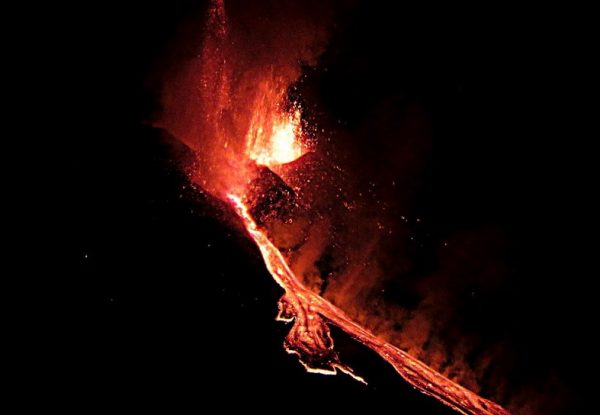When we talk about pyroclastic flows, two terrifying images come to mind: Mount Vesuvius in Italy and Mount Nevado del Ruiz in Colombia. We know about the first one, and the eruption that buried Pompeii, only thanks to the chronicles written in ancient times. The second, instead, erupted in 1985 and the world witnessed live the death of 23,000 people! The difference between the two volcanoes lies in the fact that Vesuvius caused the disaster with pyroclastic flows. While Nevado del Ruiz unleashed an avalanche of mud “due” to the pyroclastic flows. But what exactly are they? What do we mean when we say “pyroclastic flows”? And … could Mount Etna cause them?
What are the pyroclastic flows?
The term pyroclastic flow indicates a large amount of boiling material that glides at very high speed along the flanks of a volcano. It differs from the lava flow, which is thicker and often slower, although it may contain magmatic parts too. It is usually the result of a landslide or the collapse of an eruptive column. In fact it also carries ash, soil, gas and fragments of rocky material.
A pyroclastic flow precedes a lava flow but sometimes it can also occur during an eruption. For example, when part of a crater collapses or if the lava encounters piles of ice and snow. When it is the result of a landslide, the flow drags a lot of heavy material downstream. If, on the other hand, it is a volcanic cloud that collapses due to lack of wind, it causes the fallout of finer materials. But it is still dangerous for those who are in the immediate surroundings.
A pyroclastic flow can travel between 50 and 700 km per hour and carry within it temperatures ranging from 500 to almost 1000 Celsius degrees! Finding escape from such flows is almost impossible, so it is important to predict and prevent these events around densely populated volcanoes.
 Pyroclastic flows in history
Pyroclastic flows in history
The most famous pyroclastic flow in the world was the one caused by the eruption of Vesuvius in 79 AD. It canceled Pompeii, Herculaneum and other piedmont towns. In that case, the awakening of the volcano took place after centuries and a large part of the lava dome of the summit blew up. The column of ash, gas and magma rose up to 33 km and then, due to the absence of winds, collapsed on itself. After this event, Vesuvius emitted pyroclastic flows also in the 17th century and during the 20th century (1906 and 1944). It caused less damage than it did in 79 AD, but it had fatal consequences for people who lived at the foot of the cone.
In 1980 it was an American volcano – dormant for centuries- the one that woke up. Mount Saint Helens (United States). It had been sending out very specific signals for some time, so that a large part of the region had been evacuated. However, it still claimed many victims, because no one had foreseen the explosion that split an entire side of the mountain. The pyroclastic flows caused the melting of the ice and turned into flows of boiling mud (lahar), equally destructive. A similar event happened in 1985 in Colombia, with the eruption of Nevado del Ruiz which destroyed at least three towns.
In 1991 the protagonist of destructive pyroclastic flows was the Piñatubo volcano in the Philippines. The many warning signs had allowed the population to be evacuated in time. But the devastation left by the very fast flows of burning ash marked the territory of the island forever. Many other examples of these phenomena have been recorded in history, and are told with competence and many interesting details by the blog IL VULCANICO (text in Italian).
As for Etna …
As for Etna, yes, our volcano also emits pyroclastic flows. The “luck” compared to the other examples above mentioned is that the towns are located very far from the main craters. Mount Etna can emit very high volcanic clouds, which can also collapse in the immediate surroundings, but there are no houses or hotels around. The closest villages are located at the foot of the volcano, often protected by deep valleys and thousand-year-old cones.
However, the danger remains high, especially for tourists who venture to the top. Or for alpine guides who often climb, even for personal pleasure, beyond the permitted safety lines. Luckily, Mount Etna is a volcano monitored in every movement, from any side. The signals of an eruptive event will be communicated well in advance. Thanks to new technologies, the direction and strength of the winds are also constantly under control. An expert guide will always know that, with winds blowing from the north, you should never see an eruption from the south side. And viceversa.
Recently, the South East Crater – the youngest of the five active on top – was the protagonist of important paroxysms. At first, it significantly rose in height and then it broke and collapsed. In the photo above the title you can see a pyroclastic flow – now cool – generated by this collapsing.
(PHOTOS BY GRAZIA MUSUMECI)